When the sun is out, the temperature readings from my weather station are constantly high when compared to nearby official stations. This is to be expected as temperature should be measured in a Stevenson screen, not with the direct sun beating down on it. There is a screen of sorts on the sensor but it is pretty ineffective.
Regarding the positioning of thermometers, the Australian Bureau of Meteorology’s site tells us this:
A thermometer should be mounted so that air can pass freely over the bulb or sensor while being protected from direct sunlight and rain. The Stevenson screen is an instrument enclosure that meets these requirements and is the standard at official Bureau sites.
The instrument enclosure should be located in the open, over a locally natural surface (for example grass, but not concrete), unaffected by nearby obstructions such as trees and buildings (at a distance of at least twice the height of obstructions, and preferably four times), and not placed in a hollow (which would render conditions unrepresentative). The screen door should face south in the southern hemisphere to avoid direct sunlight on the thermometers when making an observation. The thermometers should be placed in the shelter at about 1.2 m above ground level.
A compromise for those unable to construct or purchase a shelter would be to hang a thermometer from the branch of a tree with thick foliage, not too close to the trunk. It is important that the bulb is never in direct sunlight or close to buildings (which can radiate heat, particularly overnight).
With the weather station I have I’m limited as all the sensors are connected via cables. The wind and rain sensors really have to stay where they are so the temperature and humidity sensors are also stuck there. I got to thinking and wondered whether I could shade the thermometer somehow.
I started thinking of a small roof mounted under the solar panel that charges the batteries but over the sensors. I thought a double layer, painted white to reflect light and with ventilation to let trapped air escape would be the go. I saw pot plant saucers used on another web site somewhere to build a screen and it occurred to me I could build a roof with them. So that is what I did today.
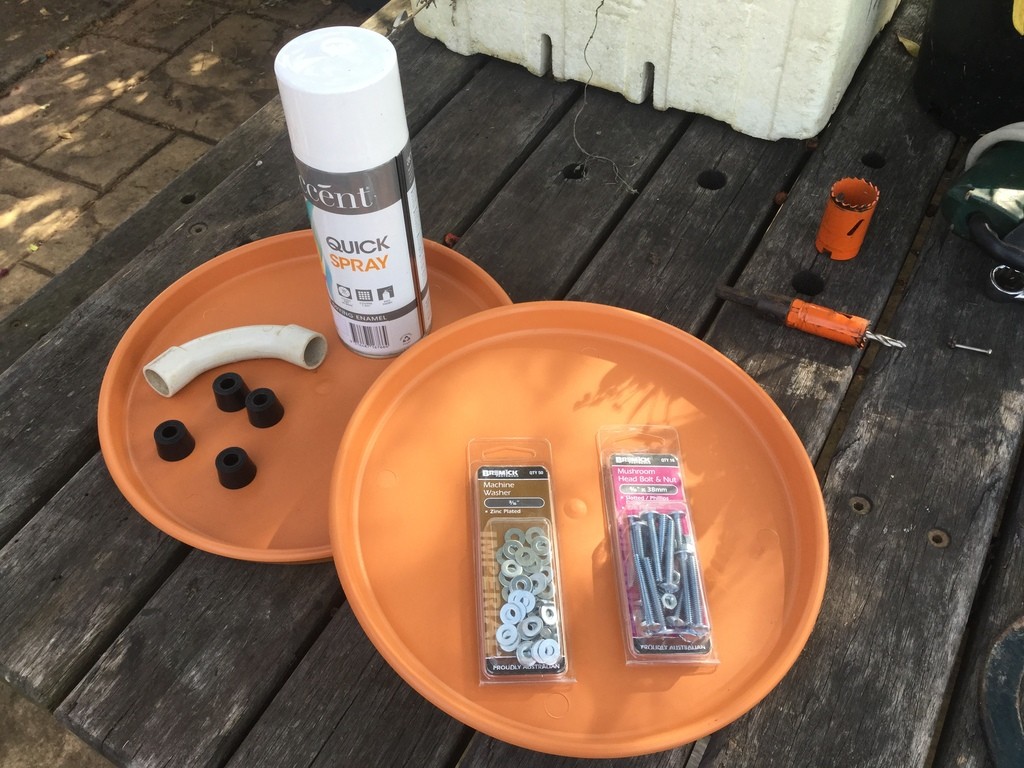 The materials: two 30cm pot plant saucers, some spacers, bolts and white enamel gloss paint. I cut the end off the conduit elbow for the centre spacer.
The materials: two 30cm pot plant saucers, some spacers, bolts and white enamel gloss paint. I cut the end off the conduit elbow for the centre spacer.
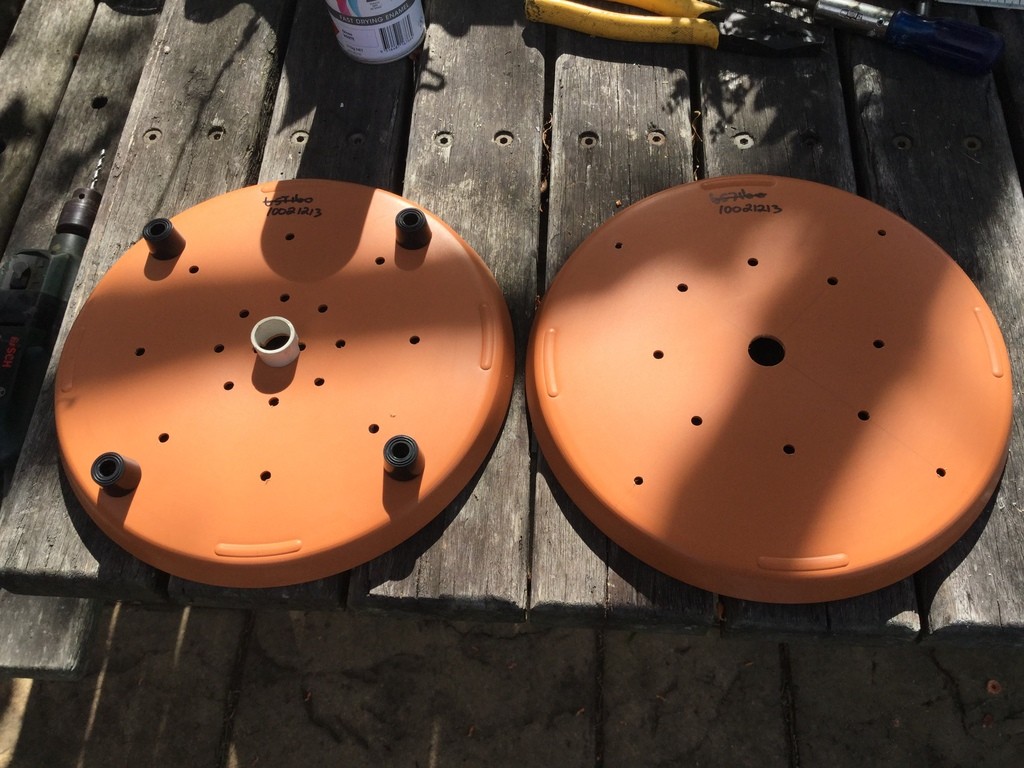 I drilled a 22mm hole in the centre of both saucers which will be used to mount the roof. I then drilled 4 x 5mm holes around the outside for the bolts and spacers. Then I drilled 16 x 6mm holes in the lower saucer and 8 x 6mm holes in the upper saucer for ventilation. The ventilation holes do not line up so as to prevent sunlight getting through.
I drilled a 22mm hole in the centre of both saucers which will be used to mount the roof. I then drilled 4 x 5mm holes around the outside for the bolts and spacers. Then I drilled 16 x 6mm holes in the lower saucer and 8 x 6mm holes in the upper saucer for ventilation. The ventilation holes do not line up so as to prevent sunlight getting through.
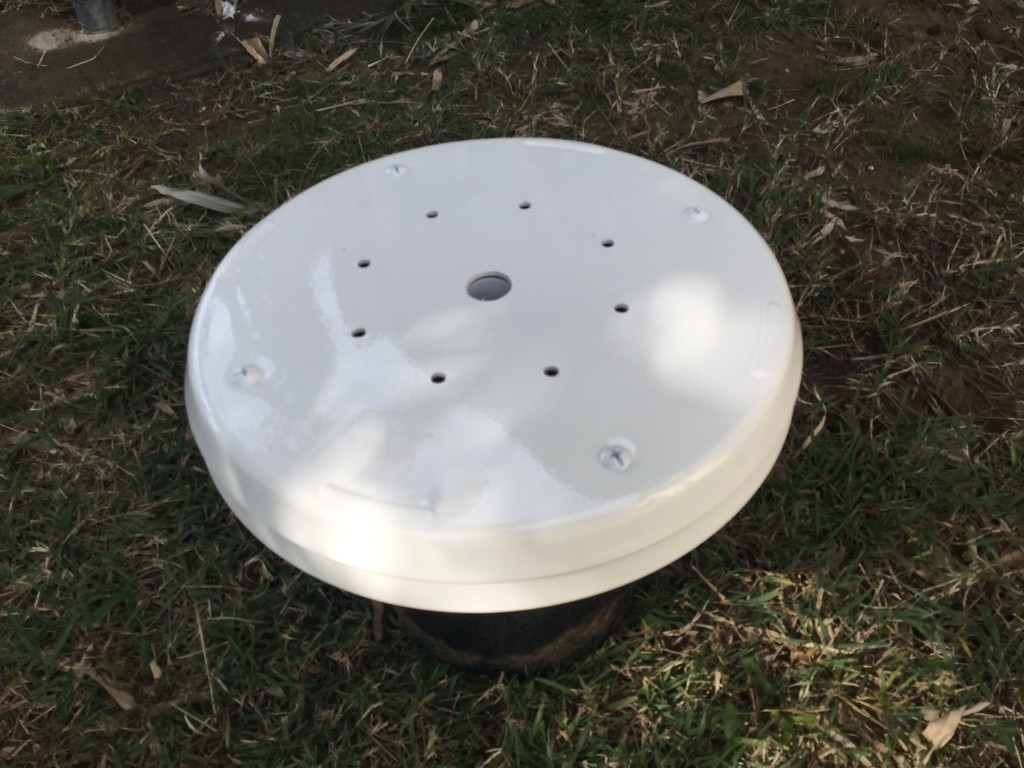 I painted the upper surface of both saucers with white enamel gloss paint to reflect light away. The underside was let unpainted so light and heat is not reflected down on the sensors.
I painted the upper surface of both saucers with white enamel gloss paint to reflect light away. The underside was let unpainted so light and heat is not reflected down on the sensors.
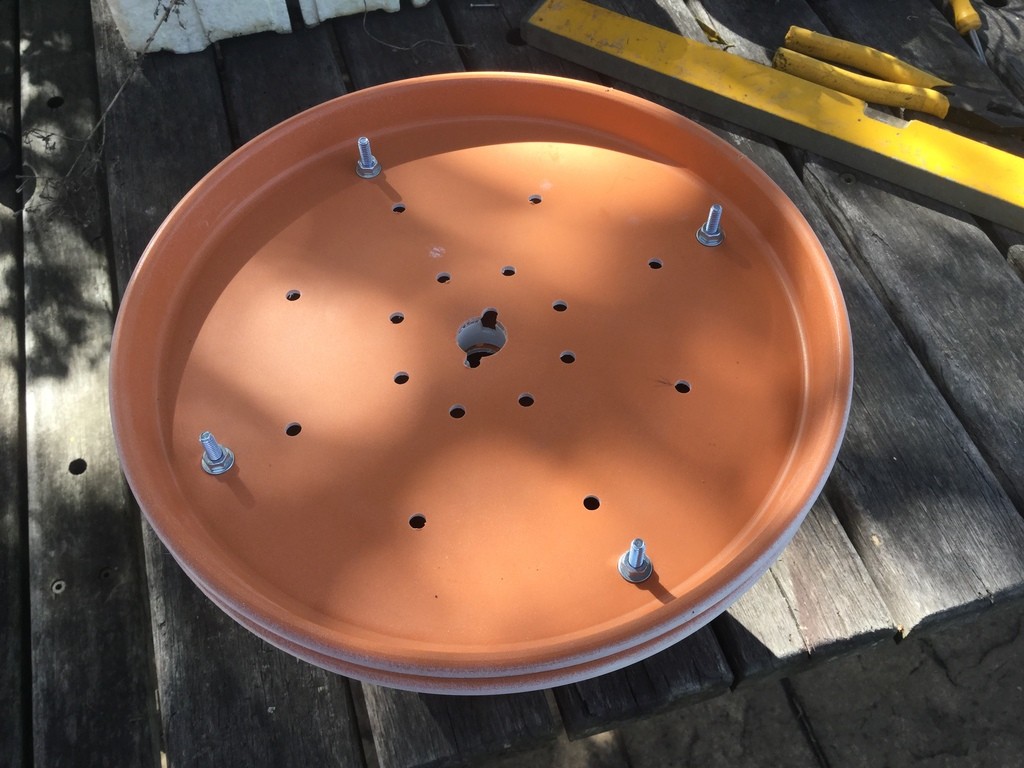 Here is the underside of the finished roof. The odd shape of the centre hole is to allow for an existing connecting bolt in the shaft where the roof will be mounted.
Here is the underside of the finished roof. The odd shape of the centre hole is to allow for an existing connecting bolt in the shaft where the roof will be mounted.
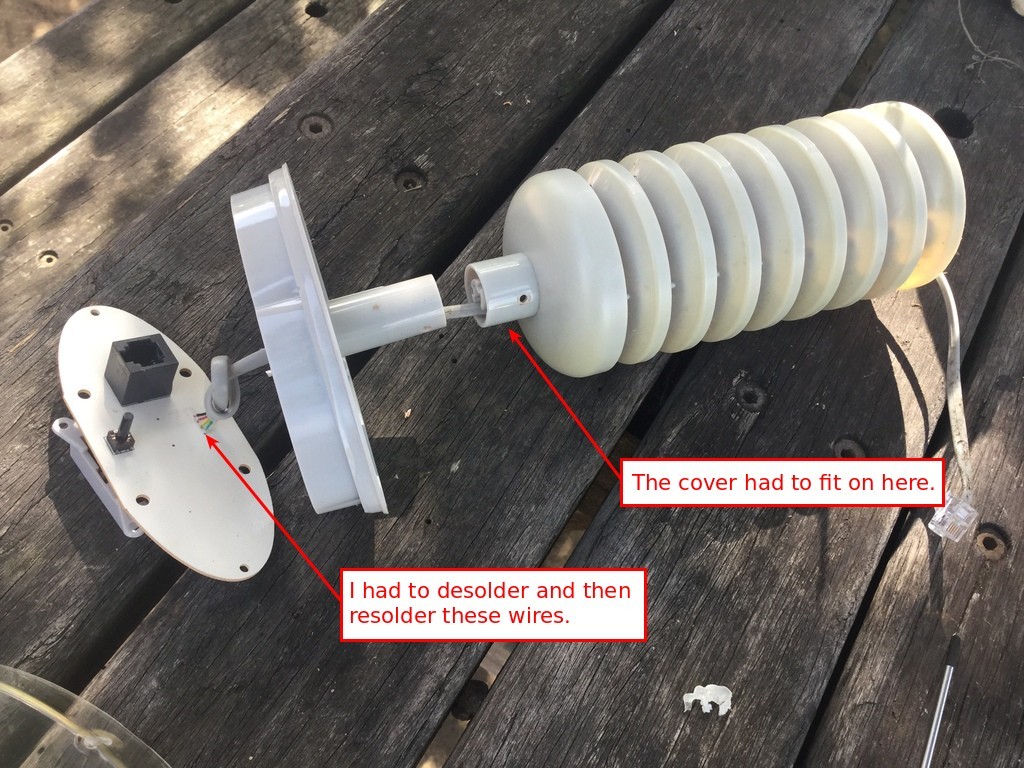 When I went to fit the roof, I had a bit of an oops moment when I realised that I couldn’t remove the cable between the solar panel and the sensor. There was nothing for it but to de-solder the connection at the solar panel, fit the roof and then resolder the wires. Not as simple as it sounds as the wires kept breaking on me.
When I went to fit the roof, I had a bit of an oops moment when I realised that I couldn’t remove the cable between the solar panel and the sensor. There was nothing for it but to de-solder the connection at the solar panel, fit the roof and then resolder the wires. Not as simple as it sounds as the wires kept breaking on me.
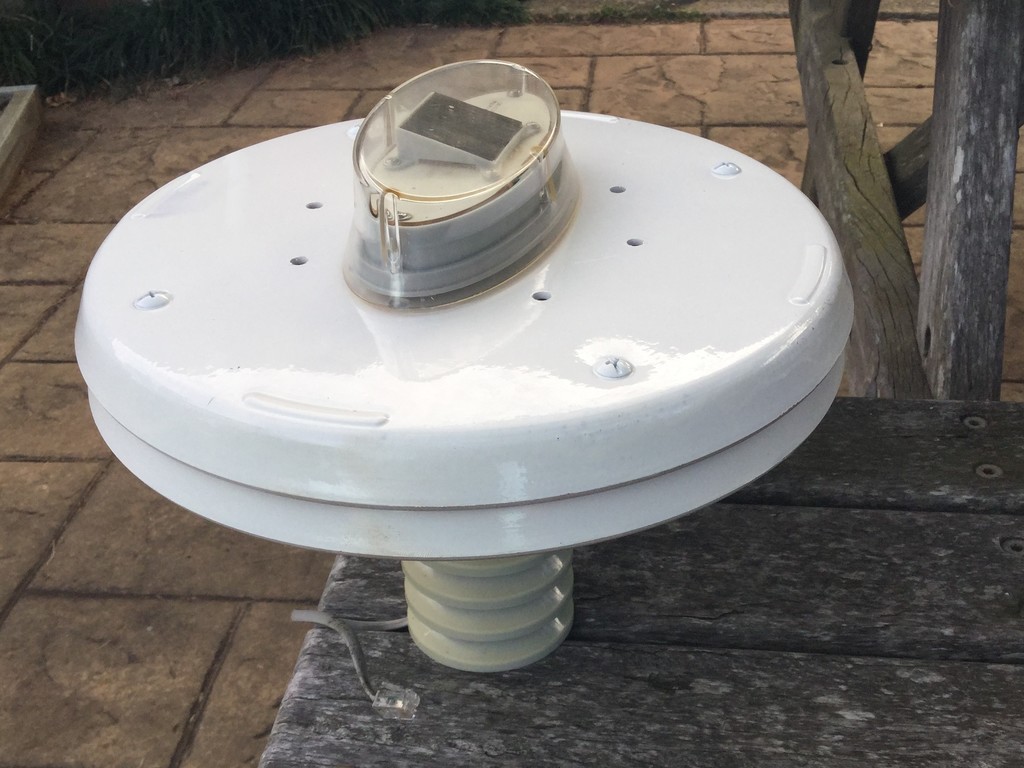 The finished product. All that remains is fit it back together and check that it is still sending data correctly. One other small issue I did have was connecting the rain gauge back up. On my station it plugs into the bottom of the solar panel unit and with the saucers there, there isn’t much room to plug the cable in. There is definitely no room for fingers so I had to lever the plug in with the help of a long screwdriver.
The finished product. All that remains is fit it back together and check that it is still sending data correctly. One other small issue I did have was connecting the rain gauge back up. On my station it plugs into the bottom of the solar panel unit and with the saucers there, there isn’t much room to plug the cable in. There is definitely no room for fingers so I had to lever the plug in with the help of a long screwdriver.
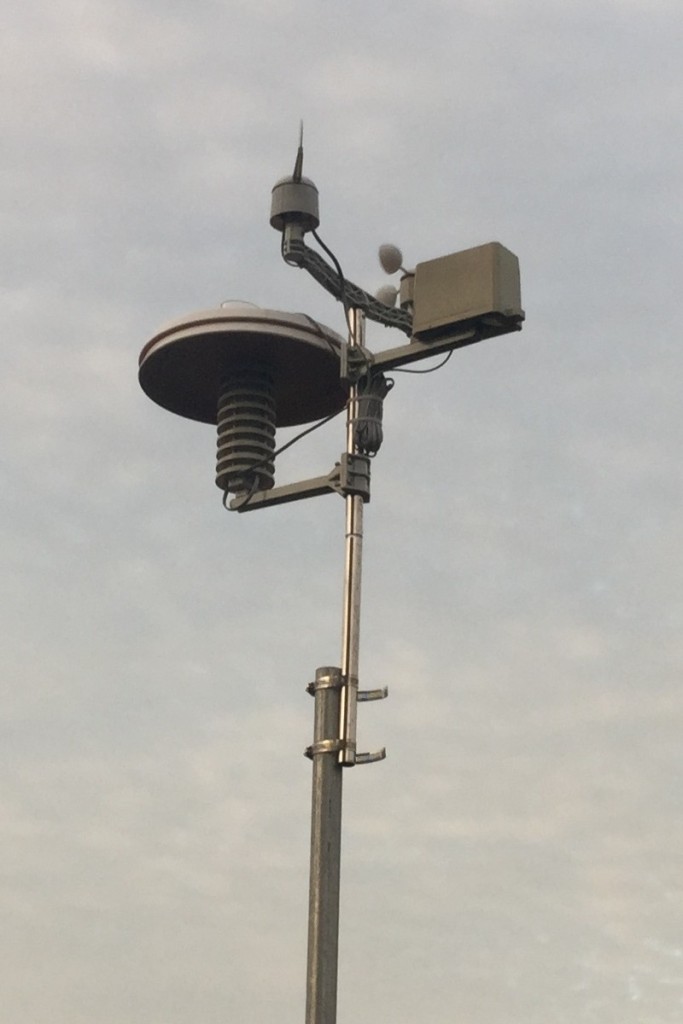 It doesn’t look too bad even if I do say so myself. My database is receiving data so it is all good.
It doesn’t look too bad even if I do say so myself. My database is receiving data so it is all good.
Now time will tell as to how successful it is.

Wow! This looks cool indeed. I am going to do this to my weather sensor too. But I have a doubt..doesn't that affect the accuracy?
Hi David, I have compared my results with the closest Bureau of Meterology sites and believe I now have more accurate results. The maximum temperatures aren't as high as they used to be as I'm no longer getting as much heating from direct sunlight. If you google Stevenson screens, you will get an idea of my logic. Of course I have nothing else to back it up.
This is an awesome technique and I gonna to do this to my weather station sensor also. I hope it will be work properly.
Now that would be great if we all worked in the shade. Our temp sensors take in the radiation and air flow. It should be taken in sunlight and shade. When I work on my driveway on the east side . I have two stucco buildings on each side of me. The temperature gauge is in a protective case on the fence. Usually reads 10 degrees warmer from the shaded sensor on my front porch facing west. When I’m working in driveway I can feel the difference immediately. I prefer the sensor to give me the same results while I’m in the sun.